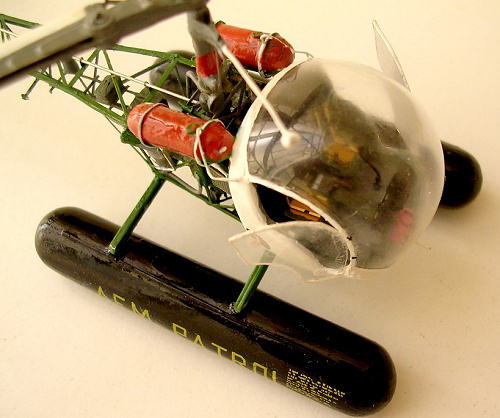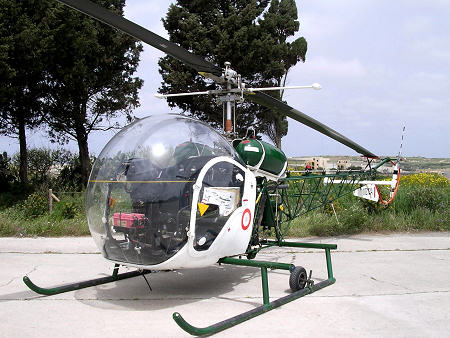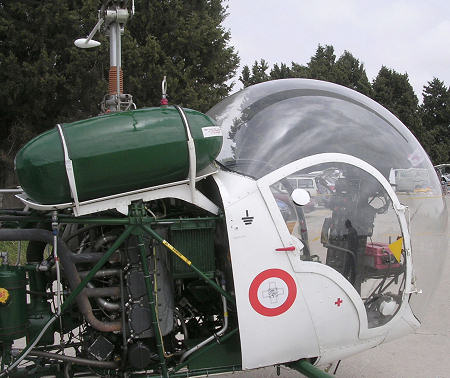
Pavla 1/72 Bell 47G
| KIT #: | ? |
| PRICE: | ? |
| DECALS: | Four options |
| REVIEWER: | Carmel J. Attard |
| NOTES: | Short run kit with vacuformed canopy. |

| HISTORY |
Circa 1972 the coastal patrol service around the Maltese archipelago comprised of several patrol boats acquired from the United States. These were eventually augmented with an air squadron following an offer by the then West Germany to assist in setting up a flight of helicopters. Personnel from the Armed Forces of Malta received helicopter flying training there and four Bell J-47G helicopters were brought in by German Transall C-160 transport aircraft to form the new 1st Regiment Flight.
The origin of the Bell J-47 goes back to 1947 when the first
example went into the air. Several thousand Bell J-47s have been built since and
even today it is still continue to meet military and civilian duties. Over 20
Air Forces used the type in several versions. The Bell J-47 is powered by a 240
HP Lycoming VO-435 engine and later versions were powered with a more up rated
engine and  include three seat arrangement. The Bell J-47 has a fuselage length
of 31’ 7” a rotor diameter of 37’ 1.5” and a gross weight of 2950 lbs. It has a
speed of 105mph and a range of 315 miles.
include three seat arrangement. The Bell J-47 has a fuselage length
of 31’ 7” a rotor diameter of 37’ 1.5” and a gross weight of 2950 lbs. It has a
speed of 105mph and a range of 315 miles.
These newly arrived helicopters at first set up an operating base at St.Patrick’s Barracks, in Malta. This lies close to St.Julians village, thus forming an SAR operational patrol around the coastal waters of Malta and Gozo. One of the Bell-47s was always fitted with floats set which could also be fitted on the other helicopters when operating over the sea. The helicopter flight soon moved to Hal-Far airfield for a short time and following that it moved to Hal-Luqa to establish a permanent base. They took up the hangars and administrative and other buildings that once were occupied by the famous No13 and 39 reconnaissance squadrons which used to be equipped with PR7 and PR9 Canberra aircraft in the RAF days and who vacated it in March 1972.
On the 1st of April 1980 the helicopter flight became part of new division of AFM that became known as task force. The Bell-47s conducted VIP flying, aerial surveys and best of all coastal patrols. The latter were very effective and more recently operating alongside Alouette III, and AB 206 helicopters, and Islanders and Bulldogs fixed wing aircraft up till present; a time when the islands alongside Lampedusa, Pantelleria and the Sicilian coast are being invaded on daily basis by clandestine immigrants crossing from north Africa and coming from as far away as Eritrea and Sudan and Ethiopia and all over Africa.
The Bell J-47G is expected to end its lifetime service at some time in summer 2006 where it is expected that the last example of these will find a permanent accommodation at the aviation museum at Ta’Qali, which is located close to il-Mosta.
| THE KIT |
The 1/72 scale model of the Bell J-47D/G issued by Pavla is
quite a unique model in several respects. More than 50% of the parts
 that come
with the kit are brass-etched components and considering its small size this is
a highly detailed model. Needless to say this is classified as a limited run,
multi media kit and is presented with a 1st class instruction sheet containing 8
pages packed with self explanatory illustrations that should make the assembly
of so many tiny components an easy task. The brass etch fret contains components
for the fuselage framework, engine and propeller links and tiny details, cockpit
interior parts, instrument panel, columns, foot pedals, as well as other
components for the side fitted casevec stretchers.
that come
with the kit are brass-etched components and considering its small size this is
a highly detailed model. Needless to say this is classified as a limited run,
multi media kit and is presented with a 1st class instruction sheet containing 8
pages packed with self explanatory illustrations that should make the assembly
of so many tiny components an easy task. The brass etch fret contains components
for the fuselage framework, engine and propeller links and tiny details, cockpit
interior parts, instrument panel, columns, foot pedals, as well as other
components for the side fitted casevec stretchers.
Other parts such as the main and tail propellers, cabin, floats, skids and support frames, fuel tanks, engine parts, instrument column and seats are injection moulded in light grey plastic. Two vac form bubble canopies in clear acetate are supplied, with one being spare. Cockpit side doors come as separate parts and are in clear acetate. Also in acetate are a windshield for each stretcher and other stretcher components that come for the Korean War CAS vac version.
Four decal options are offered and these are the following: Bell model 47G2, in the 1970s, with Maltese registration 9H-AAE belonging to the helicopter Flight armed forces which is based at Hal-Luqa (correction for incorrect printing ‘Luga’ in the instruction sheet) colour scheme of white fuselage and Brunswick green frame (not black as indicated) and markings. Incidentally this contains also decal yellow legend ‘AFM PATROL’ and yellow printed instructions that are applied to an overall black float set. Then there is a Bell model 47G (OH-13) Royal New Zealand Air Force 1991 in overall olive drab., a Bell H-13 operated by Mobile Army Surgical Hospital (MASH) in Korea 1951 and is finished in olive drab and the last example is an overall gloss sea blue for a Bell HTL-4 aerial ambulance of VMO-6, March 1951, Korea. For the US versions two insignia shaped brass etch parts are supplied to fit to the side of the fuselage frame and carry the US marking insignia on them.
| CONSTRUCTION |
Referring to 16 illustrated stages or “positions” as the steps are called in the instructions booklet easily follows the construction of the kit. This starts with the main rotor, rotor shaft detail, and then proceeds with the engine cylinders assembly and detail parts to fit to. The plastic parts need some trimming at the joint to remove finning using a sharp modelling knife. The crew cabin caters for a two seating arrangement with the floor and bulkhead come in brass etch part which is bent at two places to suite interior plastic cabin space.
After assembling the engine parts and fit them within the
fuselage frame the position of the exhaust engine pipes may need adjustment by
slightly bending these upwards while making reference to photos of the actual
machine. I have elected to make the kit to represent an AFM Malta based version
finished in an earlier scheme. I had the opportunity to visit the local flight
headquarters at Hal-Luqa recently and so could tell in some detail about the
actual colours of the local Bell J-47G2.The interior of
 cabin was gloss black while
the seating was a variety of dark grey and black shades. But I come back to the
colours at a later stage. The acetate cockpit canopy is carefully cut to bring
to fitting shape using first a pair of scissors and finally trimming it little
by little using a sharp modelling knife. The only difficulty that I encountered
was when fitting the separate doors. I elected to fix these in an open position,
if only I knew before that the Bell J-47Gs were in fact flying with the side
doors removed during the hot summer month’s patrols.
cabin was gloss black while
the seating was a variety of dark grey and black shades. But I come back to the
colours at a later stage. The acetate cockpit canopy is carefully cut to bring
to fitting shape using first a pair of scissors and finally trimming it little
by little using a sharp modelling knife. The only difficulty that I encountered
was when fitting the separate doors. I elected to fix these in an open position,
if only I knew before that the Bell J-47Gs were in fact flying with the side
doors removed during the hot summer month’s patrols.
Following my visit to the base at Hal-Luqa I can tell for sure of the following notifications
A) The upper frame of the Bell J-47G should, and here I am referring to part M1 should be fixed the other way round to that indicated in the instruction sheet, ref: Position 12. i.e. the cross angled spars should be positioned from lower left corner to the upper right corner.
B) If one select to fit the floats, there is some surface detail added to the upper of the float as shown in the float kit installation diagram. Reinforcement shown can be added using stretch sprue and plastic card pieces.
 C)
The two fuel tanks should have attached to it hold
down steel straps, two on each tank. I did these by stretching a plastic sprue
and wrapping it around a mandrel of similar diameter to those of the tanks. Then
cut two off rings for each tank assembly. If making the more recent colourscheme
these are finished overall Brunswick green and the assembly is white.
C)
The two fuel tanks should have attached to it hold
down steel straps, two on each tank. I did these by stretching a plastic sprue
and wrapping it around a mandrel of similar diameter to those of the tanks. Then
cut two off rings for each tank assembly. If making the more recent colourscheme
these are finished overall Brunswick green and the assembly is white.
D) The transmission shaft that runs along the upper frame is finished in light aircraft grey.
E) The radio and battery are removed from the mid fuselage section and a transmitter is fitted at the base of the instrument painted pinkish orange.
F) Tail rotor was white with three black equally spaced stripes.
G) A wooden main propeller is fitted on the AFM version instead of steel ones with the difference that blades were white on top and black underside and having a silver leading edge.
H) There is a landing light fitted under the port side horizontal float support (part 12 front)
I) Add fuel inlet pipes to upper fuel tanks, which connect to the aft cabin leading to the engine, and drainpipes are added to the lower end of fuel tanks. Other pipe work was added to the engine side upon reference to close-up pictures of the Bell.
 J)
Transmission cables were also added. These are in
form of thin threads, which connect the aft of engine to the tail stabiliser.
J)
Transmission cables were also added. These are in
form of thin threads, which connect the aft of engine to the tail stabiliser.
K) Add two forward antennae, a white one pointing forward and the other that is black pointing downwards and leans slightly rearwards.
L) Add two vertical links to the propeller assembly inner support.
M) A drop of Kristal Kleer is added to the propeller balance weight. There are two such weights. These will replace brass etch parts 38-41 which being flat do not give the desired effect.
N) Add a rectangular oil or fuel tank to starboard engine compartment
O) A whip VHF antenna is added under the fuselage
A general observation is that the pipe framework was of round section and with the thickness of paint it is assumed that the desired effect is achieved on the flat brass parts.
| COLORS & MARKINGS |
Constructing the Bell J-47G was a slow going process if not rather tedious at times in view of the tiny parts involved requiring delicate handling but although time consuming the assembly of the kit was satisfactorily accomplished. One final observation is that the decal sheet could have contained a stronger carrier film because it was quite a task to place for instance the ‘AFM Patrol’ in position over the floats as these tended to wrap with the risk of cracking.
| CONCLUSIONS |
From the accompanying photos Bell J-47G taken recently both at Ta’Qali and Hal-Luqa one can notice a variation of the markings from those that appeared on the same machine over 30 years ago. One can therefore make the skid based version in an update colour and markings. I have seen the float carrying Bell J-47G flying by across St.Paul’s Bay, Ghadira Bay and Golden Bay all situated at the north west of Malta on many occasions and one can say for sure that the end result of the PAVLA kit gave a good representation of the full size Bell J-47G thus adding a unique model to my VTOL section of my collection that are based locally.
July 2006
Copyright ModelingMadness.com
If you would like your product reviewed fairly and fairly quickly, please contact the editor or see other details in the Note to Contributors.